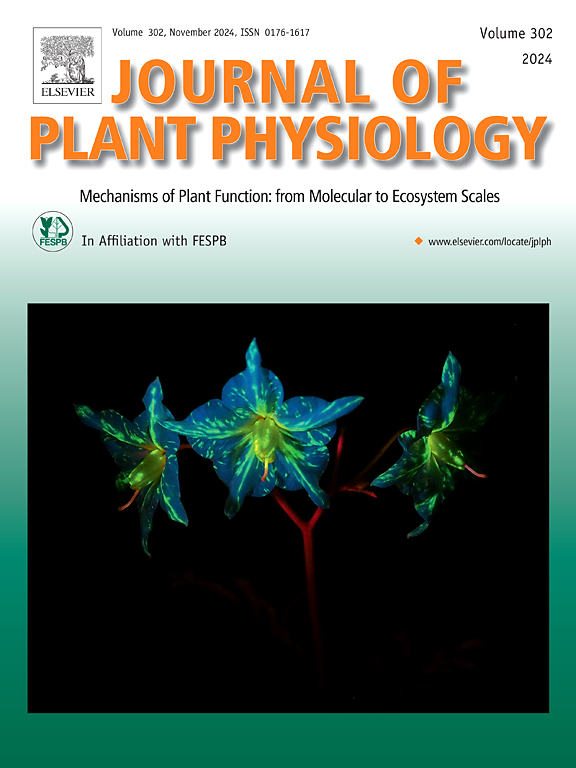Individual and interactive effects of temperature and blue light on canola growth, lignin biosynthesis and methane emissions
IF 4
3区 生物学
Q1 PLANT SCIENCES
引用次数: 0
Abstract
It is now well documented that plants produce methane (CH4) under aerobic conditions. However, the mechanisms of methane production in plants, its potential precursors, and the factors that are involved in the process are not fully understood. Few studies have considered the effects of blue light on methane emissions from plants; however, the combined effects of temperature and blue light have not been studied. We studied the effects of two temperature regimes (22/18 °C and 28/24 °C; 16 h light/8 h dark), and three blue light levels (0, 4, and 8 mW cm−2; 400–500 nm) on the growth, lignin, and methane emissions of canola (Brassica napus). Plants were grown under experimental conditions for three weeks, and then methane, monolignols and other plant traits, including growth, biomass, growth index, photosynthesis, chlorophyll fluorescence, and photosynthetic pigments, were measured. Blue light significantly increased methane emissions, stem height, and growth rate, but decreased stem diameter, leaf number and area, biomass, specific leaf mass, leaf area ratio, shoot/root mass ratio, photosynthetic pigments, sinapyl alcohol, and coniferyl aldehyde. Higher temperature significantly decreased stem diameter, non-photochemical quenching, sinapyl alcohol, and coniferyl aldehyde. Methane emission was negatively correlated with plant dry mass, leaf area per plant, and maximum quantum yield of photosystem II. However, no significant relationships were found between methane and monolignols. In conclusion, plants emitted more methane under stress conditions; however, further studies are required to understand the potential precursors of methane and the mechanism of its synthesis in plants.
温度和蓝光对油菜籽生长、木质素生物合成和甲烷排放的个体和交互影响。
现在有充分的文献证明植物在有氧条件下产生甲烷(CH4)。然而,植物产生甲烷的机制、其潜在的前体以及参与该过程的因素尚未完全了解。很少有研究考虑到蓝光对植物甲烷排放的影响;然而,温度和蓝光的联合效应尚未得到研究。我们研究了22/18°C和28/24°C两种温度制度的影响;16小时亮/8小时暗)和三个蓝光水平(0,4和8 mW cm-2;400-500 nm)对油菜生长、木质素和甲烷排放的影响。植物在实验条件下生长3周,然后测量甲烷、单脂醇和其他植物性状,包括生长、生物量、生长指数、光合作用、叶绿素荧光和光合色素。蓝光显著提高了甲烷排放量、茎高和生长率,但降低了茎粗、叶数和面积、生物量、比叶质量、叶面积比、茎根质量比、光合色素、松柏醇和松柏醛。较高的温度显著降低了茎粗、非光化学淬火、松柏醇和松柏醛。甲烷排放量与植株干质量、单株叶面积、光系统II最大量子产量呈负相关。然而,没有发现甲烷和单脂醇之间的显著关系。综上所述,植物在胁迫条件下排放更多的甲烷;然而,需要进一步的研究来了解甲烷的潜在前体及其在植物中的合成机制。
本文章由计算机程序翻译,如有差异,请以英文原文为准。
求助全文
约1分钟内获得全文
求助全文
来源期刊

Journal of plant physiology
生物-植物科学
CiteScore
7.20
自引率
4.70%
发文量
196
审稿时长
32 days
期刊介绍:
The Journal of Plant Physiology is a broad-spectrum journal that welcomes high-quality submissions in all major areas of plant physiology, including plant biochemistry, functional biotechnology, computational and synthetic plant biology, growth and development, photosynthesis and respiration, transport and translocation, plant-microbe interactions, biotic and abiotic stress. Studies are welcome at all levels of integration ranging from molecules and cells to organisms and their environments and are expected to use state-of-the-art methodologies. Pure gene expression studies are not within the focus of our journal. To be considered for publication, papers must significantly contribute to the mechanistic understanding of physiological processes, and not be merely descriptive, or confirmatory of previous results. We encourage the submission of papers that explore the physiology of non-model as well as accepted model species and those that bridge basic and applied research. For instance, studies on agricultural plants that show new physiological mechanisms to improve agricultural efficiency are welcome. Studies performed under uncontrolled situations (e.g. field conditions) not providing mechanistic insight will not be considered for publication.
The Journal of Plant Physiology publishes several types of articles: Original Research Articles, Reviews, Perspectives Articles, and Short Communications. Reviews and Perspectives will be solicited by the Editors; unsolicited reviews are also welcome but only from authors with a strong track record in the field of the review. Original research papers comprise the majority of published contributions.
 求助内容:
求助内容: 应助结果提醒方式:
应助结果提醒方式:


